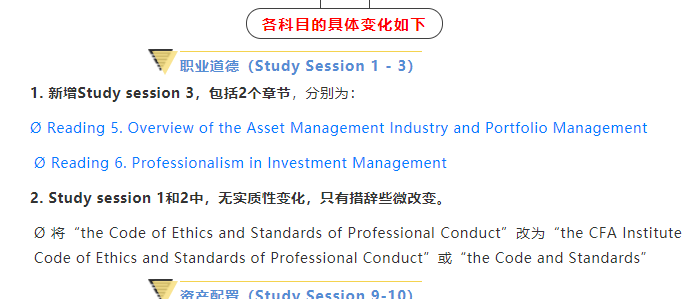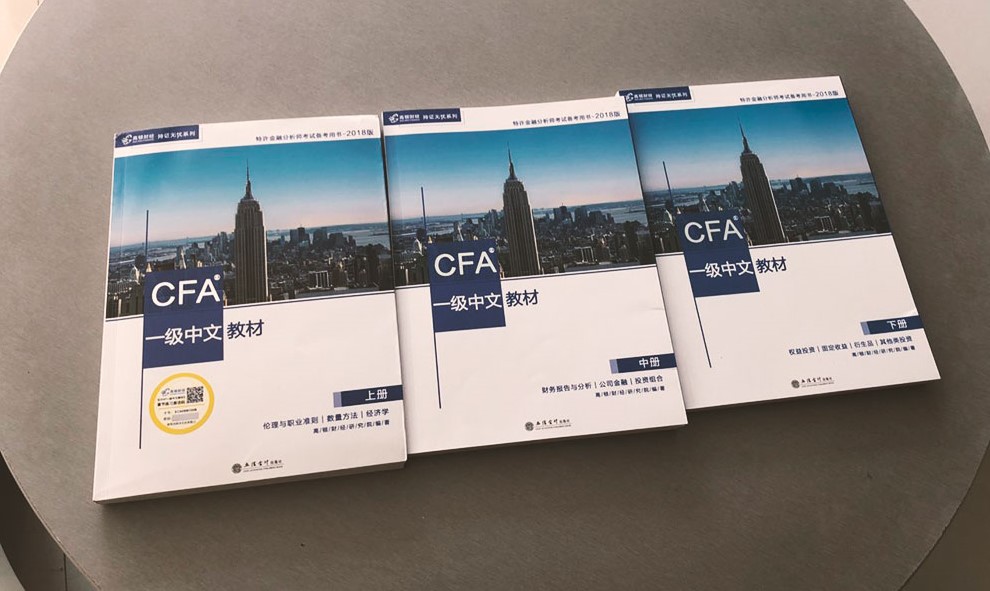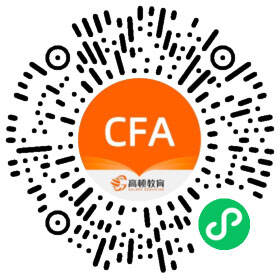CFA三級官方教材變化對比(2018-2019)
2019年CFA三個級別的考綱,均已經新鮮出爐。相較2018年,每個級別有了不同程度的變更。高頓CFA研究院專業老師傾力,為你解讀考綱變化,揣摩官方協會意圖,令你及時樹立備考風向標,把握考試動態,不做無用功!
繼去年CFA協會對三級考綱的資產配置和固定收益相關章節發生了重大變化后,今年又對權益進行了大規模的修訂。此外,職業道德、資產配置、固定收益組合管理、交易這四門科目科目的考綱發生改變。
下列科目的考綱無任何變化:
◆行為金融(Behavior Finance,SS4)
◆私人財富管理(Private Wealth Management,SS5-6)
◆機構投資的組合管理(Portfolio Management for Institutional Investors,SS7)
◆經濟分析的組合管理應用(Application of Economic Analysis to Portfolio Management,SS8)
◆另類投資的組合管理(Alternative Investments for Portfolio Management,SS15)
◆風險管理(Risk Management,SS16-17)
◆業績評估(Performance Evaluation,SS19)
◆全球投資業績標準(Global Investment Performance Standards,SS20)
下列科目發生變化:
◆職業道德(Ethical and Professional Standards,SS1-3):新增Study session 3,包括2個章節;Study session 1和2中,無實質性變化,只有措辭些微改變。
◆資產配置(Asset Allocation and Related Decision in Portfolio Management,SS9-10):Study Session 9中的Reading 18(原Reading16)刪除1條考綱;Study Session10刪除一整章。
◆固定收益組合管理(Fixed-Income Portfolio Management,SS11-12):Study Session 11無變化;Study Session 12中的Reading 24(原Reading23)新增2條考綱。
◆權益組合管理(Equity Portfolio Management,SS13-14):整個部分完全重新編寫,由原來的1個session變成2個session;修改后的Study session 13-14,包括4個章節。
◆交易(Trading,SS18):Session的名稱改變,從“Trading,Monitoring and Rebalancing”修改為“Trading”;Study Session 18(原Session16)中刪除一整章。
各科目的具體變化如下:
職業道德(Study Session 1-3)
1.新增Study session 3,包括2個章節,分別為:
★Reading 5.Overview of the Asset Management Industry and Portfolio Management
a.describe the structure of the asset management industry;
b.discuss a portfolio management process that supports achieving asset owners’objectives;
c.discuss the elements of effective investment governance.
★Reading 6.Professionalism in Investment Management
d.describe professions and how they establish trust;
e.explain professionalism in investment management;
f.describe expe
ctations of and challenges for investment management professionals.
2.Study session 1和2中,無實質性變化,只有措辭些微改變。
★將“the Code of Ethics and Standards of Professional Conduct”改為“the CFA Institute Code of Ethics and Standards of Professional Conduct”或“the Code and Standards”
資產配置(Study Session 9-10)
1.Study Session 9中的Reading 18(原Reading16)刪除1條考綱。
★Reading 18.Introduction to Asset Allocation
a.describe elements of effective investment governance and investment governance considerations in asset allocation;
2.Study Session10刪除一整章
★原Reading 20.Market Indexes and Benchmarks整章刪除。
固定收益組合管理(Study Session 11-12)
1.Study Session 11無變化
2.Study Session 12中的Reading 24(原Reading23)新增2條考綱。
★Reading 24.Yield Curve Strategies
b.explain how to execute a carry trade;
g.discuss inter-market curve strategies;
權益組合管理(Study Session 13-14)
1.整個部分完全重新編寫,由原來的1個session變成2個session。
2.修改后的Study session 13-14,包括4個章節,分別為:
★Reading 26.Introduction to Equity Portfolio Management
a.describe the roles of equities in the overall portfolio;
b.describe how an equity manager’s investment universe can be segmented;
c.describe the types of income and costs associated with owning and managing an equity portfolio and their potential effects on portfolio performance;
d.describe the potential benefits of shareholder engagement and the role an equity manager might play in shareholder engagement;
e.describe rationales for equity investment across the passive–active spectrum.
★Reading 27.Passive Equity Investing
a.discuss considerations in choosing a benchmark for a passively managed equity portfolio;
b.compare passive factor-based strategies to market-capitalization-weighted indexing;
c.compare different approaches to passive equity investing;
d.compare the full replication,stratified sampling,and optimization approaches for the construction of passively managed equity portfolios;
e.discuss potential causes of tracking error and methods to control tracking error for passively managed equity portfolios;
f.explain sources of return and risk to a passively managed equity portfolio.
★Reading 28.Active Equity Investing:Strategies
a.compare fundamental and quantitative approaches to active management;
b.analyze bottom-up active strategies,including their rationale and associated processes;
c.analyze top-down active strategies,including their rationale and associated processes;
d.analyze factor-based active strategies,including their rationale and associated processes;
e.analyze activist strategies,including their rationale and associated processes;
f.describe active strategies based on statistical arbitrage and market microstructure;
g.describe how fundamental active investment strategies are created;
h.describe how quantitative active investment strategies are created;
i.discuss equity investment style classifications.
★Reading 29.Active Equity Investing:Portfolio Construction
a.describe elements of a manager’s investment philosophy that influence the portfolio construction process;
b.discuss approaches for constructing actively managed equity portfolios;
c.distinguish between Active Share and active risk and discuss how each measure relates to a manager’s investment strategy;
d.discuss the application of risk budgeting concepts in portfolio construction;
e.discuss risk measures that are incorporated in equity portfolio construction and describe how limits set on these measures affect portfolio construction;
f.discuss how assets under management,position size,market liquidity,and portfolio turnover affect equity portfolio construction decisions;
g.*uate the efficiency of a portfolio structure given its investment mandate;
h.discuss the long-only,long extension,long/short,and equitized market-neutral approaches to equity portfolio construction,including their risks,costs,and effects on potential alphas.
交易(Study Session18)
1.Session的名稱改變,從“Trading,Monitoring and Rebalancing”修改為“Trading”
2.Study Session 18(原Session16)中刪除一整章
★原Reading 32.Monitoring and Rebalancing整章刪除。
給大家推薦一個已經考過CFA的學姐,關于CFA任何不懂的事情都可以咨詢她。不僅能解決CFA考試問題,還有電子版CFA試題和CFA備考資料:微信ID:cfaers







